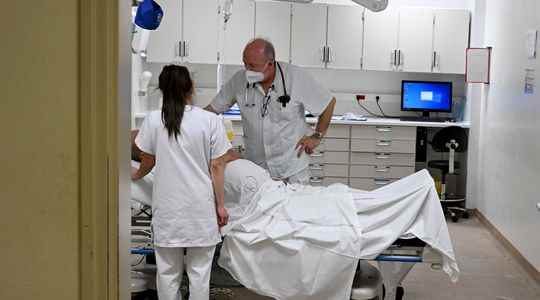This is a recurring problem that has been particularly intense in recent months. For several days, hospital services have been alarmed by the lack of nursing staff ahead of school holidays, and fear a wave of emergency room closures in the coming weeks. The Samu-Urgences de France association thus counted last week at least 120 hospitals in great difficulty of operation, half of which had to resolve to a closure, most often partial, of their emergencies, due to lack of staff.
On Tuesday, Emmanuel Macron announced a month-long mission entrusted to Professor François Braun, president of Samu-Urgences de France, to diagnose the crisis and propose ways to respond to it. The first stage of this plan to be declined on the scale of the French “1,200 living areas”, and will target territory by territory, to determine “where are the gaps”, in the words of the Minister of Health Brigitte Bourguignon .
Shortages of personnel spread throughout the territory
Beyond simple emergency services, the problem of the lack of caregivers is glaring in many specialties. To get an idea, it is possible to look at the data provided by the National Management Center. This organization publishes a list of vacancies in hospital structures in France every quarter as part of the recruitment of hospital professionals. With the spring round currently taking place, this list has been updated to April 15, 2022.
The darkest departments are those with the greatest lack of caregivers in relation to the population of the department. We have focused on three of the most critical hospital specialties in terms of vacancies. Anesthetists-resuscitators (particularly in demand during the Covid-19 crisis), as well as emergency doctors, and radiologists, specializing in medical imaging. In almost all French departments, tenured positions are vacant. With more or less disparities depending on the structures. Thus, on April 15, the Bouches-du-Rhône department officially lacked 42 positions for anesthetists-resuscitators and 28 emergency physicians. These figures have been weighted by department with regard to the number of inhabitants and therefore of hospital structures. Thus in Corrèze, a territory almost ten times less populated than the Bouches-du-Rhône, 10 emergency physicians are missing in hospitals, and only 4 anesthesiologists-resuscitators.
Paris is the department in which the total number of vacancies in these three specialties is the highest, it is also the department which includes the most hospital structures in France. More than fifty resuscitators were missing on April 15, and more than 23 emergency physicians. “It is the posts of permanent emergency physicians who are vacant, they are increasing since a certain number of these professionals are resigning in order to be able to return to work on a temporary basis and control their working time”, says Christophe Prudhomme, the spokesperson for the Association of emergency physicians of France. Although this figure does not provide a completely precise picture of the situation of hospital services, it does indicate a sometimes worrying trend. “The number of doctors missing is much higher than the number of vacant positions announced by the CNG”, continues Christophe Prudhomme, “at the Assistance-Publique Hôpitaux de Paris (APHP) out of all emergency doctors there are only 50 % of incumbents, so the vacancies are in this category, which means that there is still a lack of people”.
Structural problem of the lack of nurses
Within the hospital, the difficulties are also and especially on the nurses. Within the AP-HP the situation would even be “critical”, according to its boss, Martin Hirsch. According to him, 15% of hospital beds in these establishments in the Ile-de-France region are closed, with specific problems which “affect the nurses”. “We have 1,000 less than a year ago at the same time. We had planned to create 400 additional positions, we could not create them. So we are 1,400 nurses short of what ‘we would like to have,’ explained Martin Hirsch at the start of the week.
Hospital services everywhere are finding it difficult to find nurses. For nearly ten years, however, the hospital contingent has increased, going, according to figures from the DREES, from 388,666 in 2012 to more than 490,000 in 2021. A continuous increase, but insufficient in the face of the rise in care needs professionals. According to DREES projections, the number of nurses needed in 2040 could reach just under one million (881,000). “The aging of the population and the increase in long-term illnesses (ALD) increase the number of chronic pathologies and therefore require more care”, deciphers Patrick Chamboredon, president of the National Council of the Order of Nurses.
A structural problem of the lack of staff is well known to the institutions, but it has experienced a particularly strong acceleration with the Covid-19 crisis. “The health crisis has overmobilized nurses in the hospital, and the subsequent catch-up of deprogramming has multiplied a crisis that has existed for a long time”, underlines Patrick Chamboredon who notes that many non-medical health professionals want to leave the profession. A study carried out in December by the Order of Nurses and to which 60,000 registered respondents responded revealed that 15% of professionals said they “want to change jobs in the next 12 months”.
